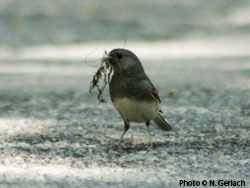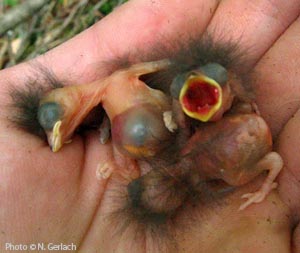Why do some but not all females engage in extra-pair behavior?
 My research involves extra-pair behavior in female dark-eyed juncos (Junco hyemalis). Extra-pair behavior in songbirds has been well-studied from the perspective of male behavior, but much less so from the female perspective. More than a quarter of all junco offspring are produced by extra-pair mating, although individual females vary from highly faithful (no EPO) to highly unfaithful (all EPO). My research is aimed at understanding the sources of this individual variation from both ultimate and proximate perspectives, as well as the effects that extra-pair behavior has on both parental and offspring fitness.
My research involves extra-pair behavior in female dark-eyed juncos (Junco hyemalis). Extra-pair behavior in songbirds has been well-studied from the perspective of male behavior, but much less so from the female perspective. More than a quarter of all junco offspring are produced by extra-pair mating, although individual females vary from highly faithful (no EPO) to highly unfaithful (all EPO). My research is aimed at understanding the sources of this individual variation from both ultimate and proximate perspectives, as well as the effects that extra-pair behavior has on both parental and offspring fitness.
To this end, I have genotyped samples from more than 2400 nestlings and adults from 1997-2012, and used these genotypes to determine the paternity of more than one thousand nestlings. I have also compiled a long-term database based on over 30 years of research conducted by members of Ellen Ketterson’s lab on free-living juncos from Mountain Lake Biological Station in Giles County, Virginia. The database contains information on the demography, morphology, and reproduction of over 16,000 individual birds, including more than 2,700 nestlings whose genetic paternity is known.
Does extra-pair behavior affect female direct fitness?
 In males of most species, mating with multiple females increases that male’s reproductive success. I have used data from 18 years and over 400 females to determine that in juncos, the converse is also true; mating with multiple males is correlated with increased offspring production by females. However, in both sexes, increased numbers of social mates have a stronger effect on reproductive success than does extra-pair mating. I am working on determining cause and effect in this relationship: does multiple mating increase female offspring production, or do more males preferentially court and mate with highly fecund females?
In males of most species, mating with multiple females increases that male’s reproductive success. I have used data from 18 years and over 400 females to determine that in juncos, the converse is also true; mating with multiple males is correlated with increased offspring production by females. However, in both sexes, increased numbers of social mates have a stronger effect on reproductive success than does extra-pair mating. I am working on determining cause and effect in this relationship: does multiple mating increase female offspring production, or do more males preferentially court and mate with highly fecund females?
CITATION: Gerlach, N. M., McGlothlin, J. W., Parker, P. G., and Ketterson, E. D. 2012. Reinterpreting Bateman gradients: multiple mating and selection in both sexes of a songbird species. Behavioral Ecology 23(5): 1078-1088.
Does extra-pair behavior affect female indirect fitness by affecting offspring performance?
 The ‘good genes’ or ‘compatible genes’ theories are frequently used to explain female participation in extra-pair behavior – they argue that females are engaging in extra-pair matings to increase the quality rather than the quantity of their offspring, by mating with high-quality or highly-compatible males. If this is true, offspring sired by extra-pair males should do better than their within-pair half-siblings. Most studies that address this question only focus on the first year of an individual’s life, but using our long-term data set, I was able to look at not only nestling and juvenile traits, but also at lifetime reproductive behavior. I found that while extra-pair offspring and within-pair offspring do not differ in a variety of traits early in life, there are significant differences in their adult reproductive behavior. Extra-pair offspring of both sexes had higher reproductive success as adults, and male extra-pair offspring were more likely to become extra-pair sires themselves.
The ‘good genes’ or ‘compatible genes’ theories are frequently used to explain female participation in extra-pair behavior – they argue that females are engaging in extra-pair matings to increase the quality rather than the quantity of their offspring, by mating with high-quality or highly-compatible males. If this is true, offspring sired by extra-pair males should do better than their within-pair half-siblings. Most studies that address this question only focus on the first year of an individual’s life, but using our long-term data set, I was able to look at not only nestling and juvenile traits, but also at lifetime reproductive behavior. I found that while extra-pair offspring and within-pair offspring do not differ in a variety of traits early in life, there are significant differences in their adult reproductive behavior. Extra-pair offspring of both sexes had higher reproductive success as adults, and male extra-pair offspring were more likely to become extra-pair sires themselves.
CITATION: Gerlach, N. M., McGlothlin, J. W., Parker, P. G., and Ketterson, E. D. 2012. Promiscuous mating produces offspring with higher lifetime fitness. Proceedings of the Royal Society B 279(1730): 860-866.
How does social mate choice influence reproductive behavior?
 If the ‘good genes’ theory of extra-pair mate choice is true, then males who gain extra-pair copulations should be of higher quality than the males who lose paternity of their social offspring. Using 18 years of data and more than 13,000 morphological measurements, I have tested this idea in the dark-eyed junco. Males that sire extra-pair offspring are significantly older and heavier, and have longer wings and tails, than males that do not sire extra-pair offspring. However, these same traits do not predict which males are likely to lose paternity; males that lost paternity of their social offspring did not differ in age, morphology, or heterozygosity from males that did not lose paternity. However, a collaboration with Dr. Danielle Whittaker revealed that odor may also be involved in extra-pair mate choice: males with a more “male-like” odor profile had higher total reproductive success, while males with a more “female-like” odor profile were more likely to lose paternity of their social offspring.
If the ‘good genes’ theory of extra-pair mate choice is true, then males who gain extra-pair copulations should be of higher quality than the males who lose paternity of their social offspring. Using 18 years of data and more than 13,000 morphological measurements, I have tested this idea in the dark-eyed junco. Males that sire extra-pair offspring are significantly older and heavier, and have longer wings and tails, than males that do not sire extra-pair offspring. However, these same traits do not predict which males are likely to lose paternity; males that lost paternity of their social offspring did not differ in age, morphology, or heterozygosity from males that did not lose paternity. However, a collaboration with Dr. Danielle Whittaker revealed that odor may also be involved in extra-pair mate choice: males with a more “male-like” odor profile had higher total reproductive success, while males with a more “female-like” odor profile were more likely to lose paternity of their social offspring.
CITATION: Whittaker, D.J., Gerlach, N.M., Soini, H.A., Novotny, M.V., and Ketterson, E.D. 2013. Bird odour predicts reproductive success. Animal Behavior 86(4): 697-703.
The relatedness of social pairs also did not affect the likelihood of a pair to produce extra-pair offspring, nor were females any less related to their extra-pair mates than to their social mates. However, pair experience did have an effect on extra-pair behavior, with the majority of nests that contained all extra-pair offspring produced by pairs that were breeding together for the first time. The success of a pair can also determine whether social pairs stay together for multiple years, or whether they find new breeding partners – a behavior that can come at a significant cost to fitness. I am continuing to work on determining how other emergent pairwise traits affect both within- and extra-pair offspring production.
What female characteristics predict extra-pair behavior?
 Females vary hugely in their mate preferences and also in their extra-pair behavior. Older females are more likely to produce extra-pair offspring, but no morphological traits covary with extra-pair behavior in females. I am currently examining the effects of individual reproductive history, as well population-scale variables such as breeding timing and synchrony, and annual effects such as predation pressure.
Females vary hugely in their mate preferences and also in their extra-pair behavior. Older females are more likely to produce extra-pair offspring, but no morphological traits covary with extra-pair behavior in females. I am currently examining the effects of individual reproductive history, as well population-scale variables such as breeding timing and synchrony, and annual effects such as predation pressure.
I have also examined this question from a mechanistic perspective, by using testosterone implants to alter the hormone profile of females during their fertile period (and therefore during the period when they would be copulating with extra-pair males.) A similar experiment in male juncos results in increased extra-pair behavior in testosterone-treated birds. However, in female juncos, testosterone does not appear to affect the rate of extra-pair offspring production. Future work will examine whether this is a result of variation in androgen sensitivity between females, or whether female extra-pair behavior is truly not mediated by testosterone.
CITATION: Gerlach, N. M. and Ketterson, E. D. 2013. Promiscuous mating produces offspring with higher lifetime fitness. Proceedings of the Royal Society B 279(1730): 860-866.